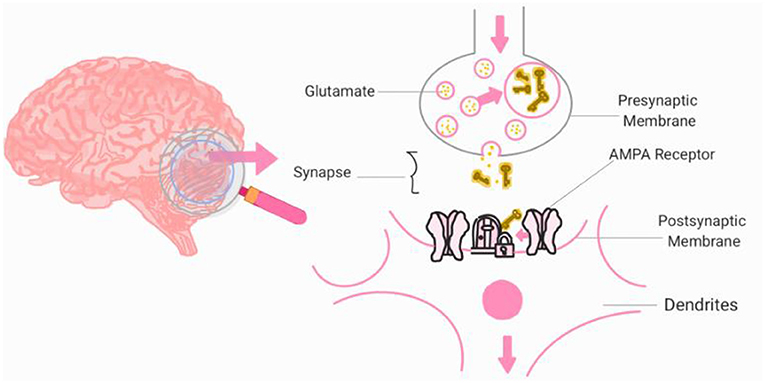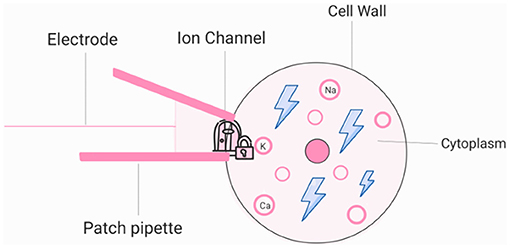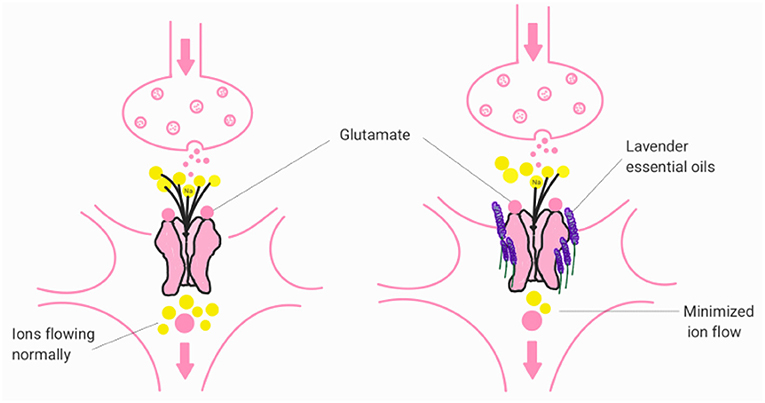Abstract
Our brain works by sending tiny messages between cells called neurons. These messages travel across small spaces called synapses, helped by special chemicals. One important part of this process is the AMPA receptor, it is like a tiny gate on a neuron that opens when a chemical called glutamate attaches to it. When the gate opens, it lets particles (called ions) rush into the neuron, helping pass the message along. But sometimes, these gates can stay open too long or too often, and that can cause trouble in the brain, like in diseases such as epilepsy or Alzheimer’s. Scientists are looking for ways to help keep these gates working just right. In our study, we looked at lavender oil, yes, the same plant that smells nice and is used in some perfumes! We found that lavender oil can help AMPA receptors stay open a little longer, but without causing damage. This might help protect the brain and could be useful for treating brain disorders in the future.
How Does Your Brain Send Messages and What Happens When Things Go Wrong?
Did you ever wonder how your brain commands your body to perform certain things, feel certain things, or even think about things? Your brain has lots of cells called neurons, which are constantly “talking” to one another. When one neuron wants to send a message to another neuron, it releases a signal in the form of chemicals called neurotransmitters. These chemicals “jump” across the little gap between neurons, which is called a synapse [1]. Once the neurotransmitter is released into the gap, it needs a way to pass the message on to the next neuron. That is where molecules called AMPA receptors come in.
You can imagine AMPA receptors as locked up tunnels, and a neurotransmitter called glutamate is like the key that fits perfectly, unlocking the tunnel and allowing it to open up. When glutamate binds to the AMPA receptor and the tunnel opens, electrically charged particles called ions can flow into the neuron (Figure 1) [2]. In this way, the message keeps traveling forward from one neuron to the next, like passing a note in class. These receptors help your brain send signals quickly and efficiently, to enable you to think, move, and react [2, 3].

- Figure 1 - Signals move from one neuron to another through a gap between cells called the synapse.
- Imagine the AMPA receptor as a locked tunnel, and a neurotransmitter called glutamate as the key that opens the tunnel. When glutamate attaches to the AMPA receptors, the tunnels open and the ions in the synapse rush into the neuron, passing on the message.
However, sometimes something can go wrong. If the AMPA receptors are not working effectively, the cellular tunnels can get stuck open. Have you ever turned on the water in a sink, forgotten about it, and it overflowed everywhere? When too many ions rush into a neuron through an open AMPA receptor, this is similar to the overflowing sink, and is called excitotoxicity. Too much excitement can actually hurt the neuron, leading to illnesses like epilepsy, Alzheimer’s disease, and Parkinson’s disease [2]. These are serious problems, so scientists are working on finding ways to control the operation of AMPA receptors. They would like to ensure that the tiny tunnels open only at the appropriate time, and do not cause harm. Some scientists have tested natural compounds that might be able to help [3].
Can Lavender Help Keep Your Brain Healthy?
Lavender is a plant that people have used for a long time to help with headaches and other problems. There are 45 kinds of lavender, and now scientists are interested in it because it might help protect the brain, especially as the number of hard-to-treat brain-related illnesses grows. One special type of lavender, Lavandula coronopifolia, grows in the desert and may help your brain by making sure that the AMPA receptors work properly, letting the right amount of ions into the neurons [4].
Studying The Effects of Lavender Oil on AMPA Receptors
We picked leaves from Lavandula coronopifolia in Jenin, Palestine, and used a machine to heat the plant parts in water until the oil came out. After that, we purified the oil and kept it cool in the fridge. We then used two machines. One machine separates the oil into its different parts, and the other machine helps us figure out what each part is. We used helium gas to help move the oil, and slowly made the gas hotter to see all the different ingredients.
After learning what was inside the oil, we wanted to see how it affects brain cells. To do this, we used a technique called Whole-cell patch clamp. It is a way scientists can measure tiny electric signals in a single cell. We first place a very thin glass pipette (like a tiny straw) on the surface of the cell. Then we gently attach it to the cell’s outer layer and open a small pathway to reach the inside. This lets us record the cell’s electrical activity and see how it changes when we add lavender oil. With this technique, we could watch how AMPA receptors reacted in real time (Figure 2).

- Figure 2 - The whole-cell patch clamp technique helps scientists measure how ions like sodium (Na), potassium (K), and calcium (Ca) move in and out of a neuron.
- A tiny glass pipette (like a super small straw) gently attaches to the cell’s surface and forms a seal. Inside the pipette is a thin wire called an electrode, which picks up electrical signals from inside the cell.
Can Lavender Oil Help Control How Brain Signals Work?
Before testing the oil, we looked at two ways AMPA receptors normally shut off. One is called desensitization, which happens when the receptor stops responding even though glutamate is still there. The other is deactivation, which is how fast the receptor closes after glutamate is gone. These “off-switches” are important for keeping brain signals under control, and when they do not work properly, they can lead to problems like epilepsy or other brain diseases.
When we added lavender oil, we saw that both of these shut-off processes slowed down. The receptors stayed active for a bit longer than usual. This gentle effect might help the brain keep its signals in better balance, especially in conditions where brain cells become too active (Figure 3).

- Figure 3 - The effects of lavender essential oil on the gating of AMPA receptors.
- Normally, when glutamate activates these receptors, a tunnel opens and ions flow into the neuron. After adding lavender oil, the receptors became less responsive, letting fewer ions through. With longer exposure, the receptors deactivated and stopped responding. This calming effect helps prevent overstimulation in the brain, which could be helpful in treating diseases like epilepsy or neurodegeneration, where brain cells become too active.
Why This Matters for our Brains?
Even though it might seem surprising, something as simple as lavender oil could help scientists better understand how to keep brain signals balanced. In this study, we found that lavender oil gently changes how AMPA receptors shut off, without blocking them completely. That kind of effect could be helpful in conditions like epilepsy or other brain disorders where signals are too strong or last too long. While more research is still needed, these results show how natural ingredients might one day play a role in protecting the brain, and that even plants can have a powerful connection to neuroscience.
Glossary
Neurotransmitters: ↑ Tiny chemicals that carry messages between neurons by crossing the synapse.
Synapse: ↑ A small gap between neurons where neurotransmitters “jump” across to move a signal from one cell to another.
AMPA Receptor: ↑ A type of receptor in the brain that helps neurons communicate. It acts like a tiny tunnel that can let ions flow into the cell.
Glutamate: ↑ A powerful neurotransmitter that helps brain cells send signals quickly and strongly.
Excitotoxicity: ↑ A harmful condition in which neurons become overly excited and get damaged.
Whole-cell Patch Clamp: ↑ A lab method where scientists gently “listen” to all the tiny electrical signals inside a cell by connecting a special glass tool to it.
Desensitization: ↑ A process where a receptor becomes less responsive while the signal (like glutamate) is still present, meaning it stops working even though the signal has not gone away yet.
Deactivation: ↑ The process of a receptor turning off and stopping its activity after the signal has ended, helping to control how long a brain signal lasts.
Conflict of Interest
The authors declare that the research was conducted in the absence of any commercial or financial relationships that could be construed as a potential conflict of interest.
Acknowledgments
MQ would like to thank our young reviewer, Anna, for her thoughtful and insightful feedback. Anna is a 16-year-old high school student with a passion for science, English literature, and art. Her curiosity and dedication to learning were evident in her review, and her suggestions helped make our article clearer and more engaging for young readers. Thank you, Anna, for your valuable contribution!
AI tool statement
Any alternative text (alt text) provided alongside figures in this article has been generated by Frontiers with the support of artificial intelligence and reasonable efforts have been made to ensure accuracy, including review by the authors wherever possible. If you identify any issues, please contact us.
Original Source Article
↑Qneibi, M., Jaradat, N., Al-Maharik, N., Hawash, M., Issa, L., Suboh, S., et al. 2023. The effect of Lavandula coronopifolia essential oil on the biophysical properties of desensitization and deactivation gating currents in ionotropic receptors. Sci. Rep. 13:8417. doi: 10.1038/s41598-023-35698-0
References
[1] ↑ The principles of nerve cell communication. 1997. Alcohol Health Res. World 21:107–8.
[2] ↑ Chang, P. K., Verbich, D., and McKinney, R. A. 2012. AMPA receptors as drug targets in neurological disease–advantages, caveats, and future outlook. Eur. J. Neurosci. 35:1908–16. doi: 10.1111/j.1460-9568.2012.08165.x
[3] ↑ Henley, J. M., and Wilkinson, K. A. 2013. AMPA receptor trafficking and the mechanisms underlying synaptic plasticity and cognitive aging. Dialogues Clin. Neurosci. 15:11–27. doi: 10.31887/DCNS.2013.15.1/jhenley
[4] ↑ Qneibi, M., Jaradat, N., Al-Maharik, N., Hawash, M., Issa, L., Suboh, S., et al. 2023. The effect of Lavandula coronopifolia essential oil on the biophysical properties of desensitization and deactivation gating currents in ionotropic receptors. Sci. Rep. 13:8417. doi: 10.1038/s41598-023-35698-0
